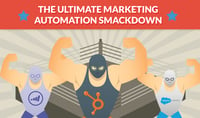
How To Use Marketing Automation To Drive Product Upsells
November 21, 2019
By Jen Spencer
While the importance of retaining an existing customer is widely known, many marketing, client fulfillment, and sales teams miss out on the opportunity to upsell.
It's understandable, given that most bandwidth at this stage typically is focused on providing the best solution and service—but it's not what's best for your business or, in many cases, your client.
Don't worry—all hope isn't lost. We live in an age where marketing automation tools (such as HubSpot and Marketo) can make complex processes simple, taking legwork off your team to help drive additional revenue while making customers aware of all the opportunities they have with your company.
Here are three effective ways to drive product upsells using marketing automation:
1. Use Lead Nurture to Sell Additional Products/Upgrades
Email marketing on its own is a fantastic way to keep in touch with your customers—but when paired with automation, it can be an effective tool to nurture and upsell without detracting from your team's current workload.
You have a few options here on how to proceed, but if you're just getting started, we recommend setting up an introductory email nurturing campaign for new customers that is triggered every week, every month, or when appropriate based on lifecycle.
It's best if these communications come from the company in general or a specific person who isn't having day-to-day interactions with customers, so it serves as an outside check-in.
These emails are not the place to craft a sales pitch—they should instead focus on educating and helping customers learn more about your company and how their needs can or will be solved. However, as time progresses, you can start to provide more information on your offerings and opportunities outside of what they've already purchased. Just keep the focus on the benefits and problems that will be solved.
For example: Say your financial institution marketing strategy targeted a "Newlywed Nancy" persona (assuming you already have your personas in order) and successfully on-boarded hundreds of newly married couples who are starting to merge their finances and plan for the future.
A logical step would be a congratulatory email from the owner of the branch on their nuptials and reassuring that they're in good hands with your company. Over the next few months (and even years), the same owner could send helpful content or examples of other customers relating to paying off loans, comparing a 401k vs a Roth IRA, saving for a mortgage, etc.
These lead nurture campaigns can be very effective in establishing customer trust and helping them move forward with more of your company's offerings.

2. Use Web Behavior to Indicate Interest In Products/Services/Topics
Another big opportunity to engage with customers is to personalize their experience on your website—you can use smart content to serve up different CTAs, skip certain forms, or even mention them by name on your homepage.
A customer will appreciate the personal touch in serving them content that is more relatable to their needs, and they're more than likely to stick around and see what is being offered.
You have a few options on how to get started, but typically, you'd want to pick a number of key identifiers within your customer base and tailor toward that.
Let's pretend you're an education software company with different service offerings for elementary schools, middle schools, and high schools. By collecting that education level information on forms (or adding them to smart lists when they become a customer), you can curate blog posts, CTAs, and e-books to their needs and what you want them to know about.
This way, the customer is able to access relevant resources without having to sift through all non-applicable content offerings—and leaving your site before having a chance to read useful information.
Also, it's worth mentioning that you should have notifications set when a customer is browsing pages on your website, which can help indicate they are interested in upgrading their services. Once you are notified, you can give this customer a call to discuss the upsell options or add them into a drip campaign.
3. Implement Automated Surveys
Surveys can help gauge how happy your customers are and get feedback that they might not think to give (or be comfortable with sharing) in a face-to-face situation.
The frequency and timetable for sending surveys is entirely dependent on your business and customer lifecycle—because a survey after a month of living at a senior care facility is appropriate but given the timeline of manufacturing production and delivery, it might be better to send a survey after three months of signing with an industrial buyer.
Once you collect the insight, you can use a net promoter score system or another other similar model in order to quantify how satisfied they are. This is a way to improve your business if the feedback is positive or negative. For unsatisfied customers, ensure you have a team or system in place to address their concerns, but for highly satisfied customers, target them with product or service upsells.
Just make sure you keep upsell suggestions based on your audience and their need—because too many recommendations may overwhelm and turn off the customer. Also, each upsell should bring a legitimate solution to their problems, helping you win additional revenue with ease.
This post was originally published in August 2017 and has been updated since.

About the author
Jen Spencer oversees all operations, executing on SmartBug's growth and market expansion strategy, which is focused on delivering superior, cutting-edge service to the company's customers and partners while continuing to invest in the people and culture that make SmartBug® a great place for employees to work and develop their careers. Read more articles by Jen Spencer.


















.png?width=200&height=260&name=Ultimate%20Guide%20to%20Hiring%20an%20Agency%20(2).png)



